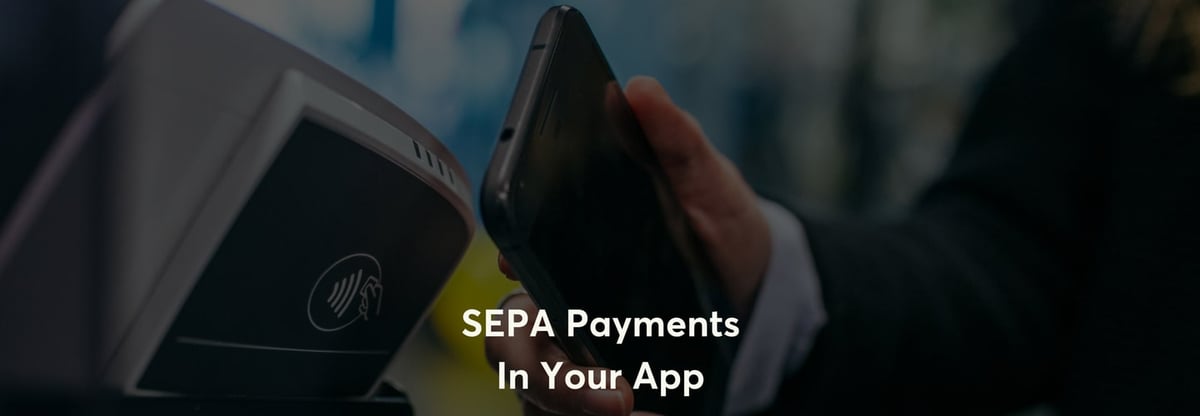What Are SEPA Payments and Why Are They Important in Fintech?

And the subsequent wave of transformation that it has sparked shows no signs of stopping.
Working at Netguru, I’ve had an opportunity to get hands-on experience in the fintech world. In 2018, I worked on a project that integrated the SEPA payments scheme for an online lender and this has allowed them to automate their core business processes.
SEPA payments have paved the way for some of the most innovative companies in the fintech space, such as Revolut and TransferWise, to provide a new way of payments and transfers.

Below, we'll examine what SEPA payments are and explore why they are important in fintech.
What is SEPA, and what are SEPA payments?
SEPA stands for Single Euro Payments Area. It’s a financial initiative that allows people to make cashless euro payments to any account in the SEPA zone. Put simply, SEPA turns cross-border payments into domestic payments and increases ease of making transactions, whether between businesses or individuals, across the SEPA zone.
How did SEPA impact the fintech space?
SEPA enabled fintech companies such as Revolut and TransferWise to transfer money in euros to bank accounts in the SEPA zone within one working day. It also made those transfers cost-free for the parties involved.
As a result, SEPA saved companies time and money that they would otherwise spend on putting together a unified, simple payment solution for the rigid European financial market.
What countries are in the SEPA zone?
The SEPA zone consists of 36 European countries. Several of these countries are not members of the euro area or European Union.
What kinds of payments can you make through SEPA?
You can make three kinds of payments through SEPA:
- Credit transfers: A one-off bank transfer that a company can send to another account in the SEPA zone.
- Direct debit payments: A pull-based transfer from a customer’s account or a business account to an initiating company’s account. To authorize this type of transfer to the initiating company, a mandate must be received.
- Cards framework: A transfer made from a customer’s debit or credit card to a vendor’s account. Customers can also make ATM withdrawals with their debit or credit cards, as well as use these for points-of-sale transactions across the SEPA zone.

What about other currencies?
SEPA is only for euro-denominated payments. It’s still possible to make a euro payment, even if both accounts are not euro-denominated. However, this requires additional costs because the currencies need to be converted to euros.
Why would fintech companies want to use SEPA payments?
For fintech companies that provide peer-to-peer money transfer services, SEPA skyrockets the number of transactions that Europeans can make on their apps.
Other types of apps can benefit from SEPA, too. For example, SEPA credit transfers allow online lending companies to make payouts to their customers. Additionally, Direct Debit allows them to collect payments, regardless of whether the customer is online on the app or not.
Direct Debit is also an excellent tool for companies that offer subscription plans, and companies that are in long-term trade agreements with trusted partners. Since they collect recurring payments from customers, these companies can use Direct Debit to automate their collection process.
How can an automated SEPA payments scheme benefit your business?
Armed with an automated SEPA payments scheme, you can enhance your business’s flexibility, reduce your overhead, collect payments on time, widen your customer base, and boost your scalability.

Flexibility
An automated SEPA payments scheme can dynamically calculate the amount of money needed for payout or repayment and trigger that payment exactly when it’s needed. For example, through SEPA Direct Debit, the amount of money your business claims it’s owed doesn’t have to be fixed. Depending on the circumstances, you can change the charge.
Reduced overhead
An automated SEPA payments scheme can automatically trigger payments, monitor payment statuses, and notify users about missed payments. This reduces the work for your underwriting and collection teams.
Timely collections
Instead of depending on customers to make payments, which may cause delays, an automated SEPA payments scheme can automatically pull payments on time. This gives your business more control over collections and translates to better cash flow.
Widened customer base
SEPA is extremely easy to sign up for. Customers need only one bank account in a SEPA zone country to send SEPA payments. They don’t even need a credit card. More than 520 million people live in the SEPA zone, and SEPA’s ease of use has facilitated more than 122 billion electronic payments per year. Therefore, adopting SEPA can attract new customers to your business.
Scalability
SEPA is a single automated payment scheme that requires businesses in different SEPA zone countries to operate by the same set of principles. This allows you to do business in a lot of countries and with many customers that you otherwise might not have been able to reach.

How do SEPA payments benefit your customers?
SEPA payments also benefit your customers by automating payments, protecting their finances, and providing mobility.
Automation
With SEPA’s Direct Debit scheme, customers don’t have to manually submit their payments. This simplifies the customer journey and leads to a better user experience.
Financial Protection
SEPA has one of the most lenient refund policies. Customers can ask for their money back, without giving a reason, for up to eight weeks after executing a Direct Debit. The bank must also accept the refund. This protects customers from inaccurate debits.
Mobility
Your customers can deposit and send funds to and from their bank accounts while they’re in any country in the SEPA area. This makes it convenient for them to access their funds in the entire EU and other parts of Europe.
Which companies use SEPA payments?
It’s easier to single out the companies that aren’t using SEPA payments than the ones that are. The following fintech leaders have already implemented the scheme:
With this juggernaut of fintech companies all adopting SEPA, the scheme’s prevalence and relevance in Europe have been further solidified.
How do you implement SEPA payments onto your app?
If your business is considering implementing SEPA payments, there are two ways to do it:
- Implementing the whole infrastructure yourself and communicating directly with your partner bank
- Using a SEPA payment solutions provider that will facilitate the payment management process, like Solarisbank, Stripe, and GoCardless
Here’s a rundown of each option.

Building a custom implementation and integrating through your bank
If you build an infrastructure yourself, you will have to communicate directly with your bank to process payments. You will also need to implement a communication platform based on the technology that your bank uses. This technology may differ between each individual bank.
In Germany and France, for example, you will have to obtain access to your bank’s EBICS (Electronic Banking Internet Communication Standard), a set of rules that regulates the exchange of payment information between banks.
Based on their regulations, you would need to set up an authentication system and send structured messages to execute any actions you want to take. The development of such a solution completely depends on the bank’s existing infrastructure and processes.
Partnering With an existing SEPA provider
You can offload setting up of the complex communication system between you and your partner bank to SEPA providers, such as Solarisbank, Stripe, and GoCardless. To handle SEPA payments, you will use their infrastructure. These providers expose their API to perform requests (usually through HTTP and JSON), which makes the process much easier.
.jpeg?width=791&name=solaris-preview%20(1).jpeg)
SEPA providers can also offer additional services, such as scoring and risk management. They can even help you alleviate some of the legal and administrative burdens that come with implementing SEPA payments. You’ll need to pay a fee for these services, which they usually charge on a per-transaction basis.
Additionally, some of these providers might hold a banking license (e.g., digital banking platforms), which enables you to open a bank account with them.
What is the suitable option for your business?
To choose the right option for implementing SEPA onto your app, you’ll need to consider your company’s location, the providers available, and the costs each option will incur.
At first glance, setting up an entire infrastructure yourself seems like the more expensive choice due to the time required to build the infrastructure and to its associated overhead costs. However, depending on the size of your business and the number of payments it processes, developing an infrastructure on your own may cost less than partnering with a SEPA provider in the long run. This is because these providers charge additional fees, on top of their regular payment fees.
Legal issues to consider
For both of the options above, there are a few legal steps you need to take. The first one is to open a bank account in the SEPA zone.
The second one is to obtain a Creditor Identifier. A Creditor Identifier is your unique identifier for each SEPA payment that you initiate with Direct Debit. To apply for one, you need to contact your bank or government agency. Some additional steps might be required in different countries.
Managing SEPA’s payment flow
Regardless of whether you implement SEPA by yourself or with the help of a provider, there are still a few critical parts of SEPA’s payment flow that you’ll need to manage on your own.
Triggers and actions
Even if you use a SEPA provider’s API, you still need to properly communicate with it to trigger the actions that you want it to perform. For example, if you make a payback on your loan after the due date, you will need to communicate with the API to register the same. However, if you were to choose to set up SEPA payments directly with your partner bank, you may need to undertake even more work to make a late payment on a loan.
Direct Debit mandates
If you use Direct Debit, you need to develop a system for managing SEPA Mandates, which authorize you to pull payments from your customers’ account. To qualify for Mandates, you must properly generate, store, and display them according to SEPA specifications. These Mandates are subject to cancellation and amendments.
Payment life cycle
When you process your payments, you need to interact with the different stages of its life cycle. These can range from successful, pending because the bank is reviewing the transaction, rejected due to insufficient funds in a customer’s account, or failure due to a connectivity issue with a SEPA provider’s interface.
You should also consider differentiating between payments that are successful but haven’t been transferred yet and the ones that have already gone through.
Returns and Refunds
SEPA Direct Debits are subject to refunds and returns. A client can submit a refund request up to eight weeks after you execute a Direct Debit. A bank can also return a payment due to an issue with mandate authorization. Additionally, if you fix a mandate issue, you might need to implement some logic that can handle the pending Direct Debit requests.
Make sure you set up a team or workflow that can handle customer refund requests and mandate issues.
Notifications
SEPA has two different types of notifications. The first is mandatory notifications, which are notifications that you need to send 14 days before you pull money from a customer’s account through the Direct Debit scheme.
The second is simple notifications, which can be emails you send to customers after you successfully deliver a payment through the SEPA Credit Transfer scheme.
Any issues with SEPA? Reach out to Netguru
This is just a brief overview of what the world of SEPA payments looks like. Let me know if you would like me to dive deeper into any of the SEPA-related topics! If you have any issues with SEPA implementations, please reach out to us!







